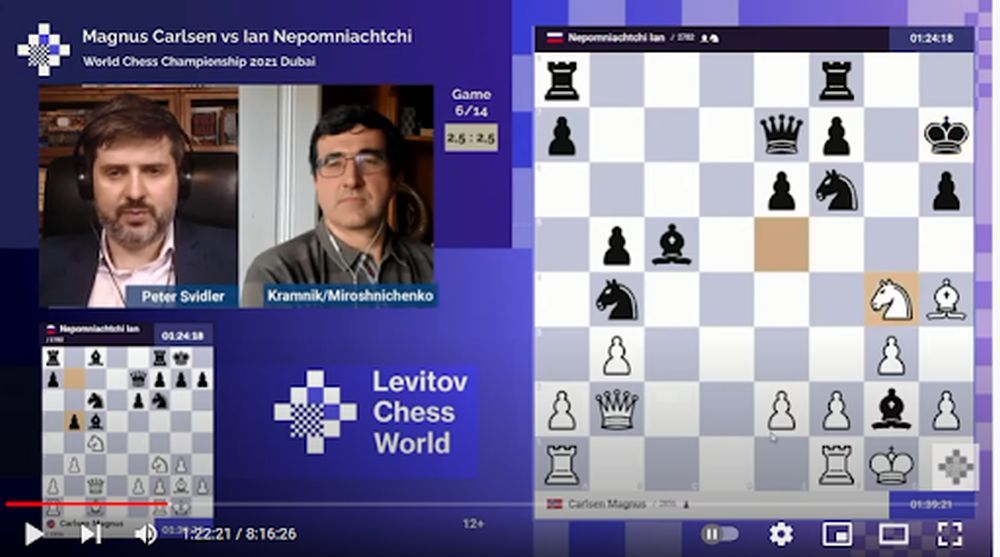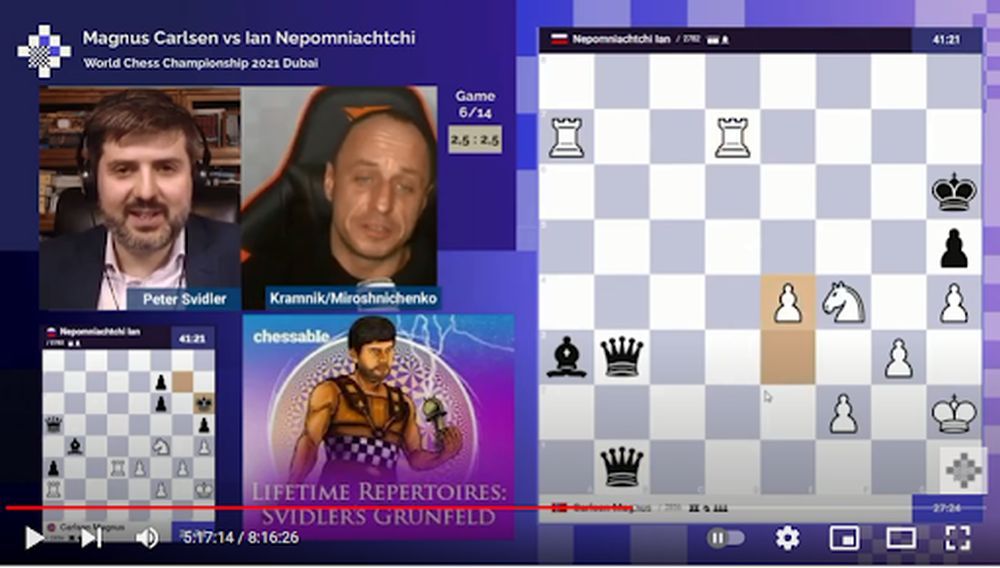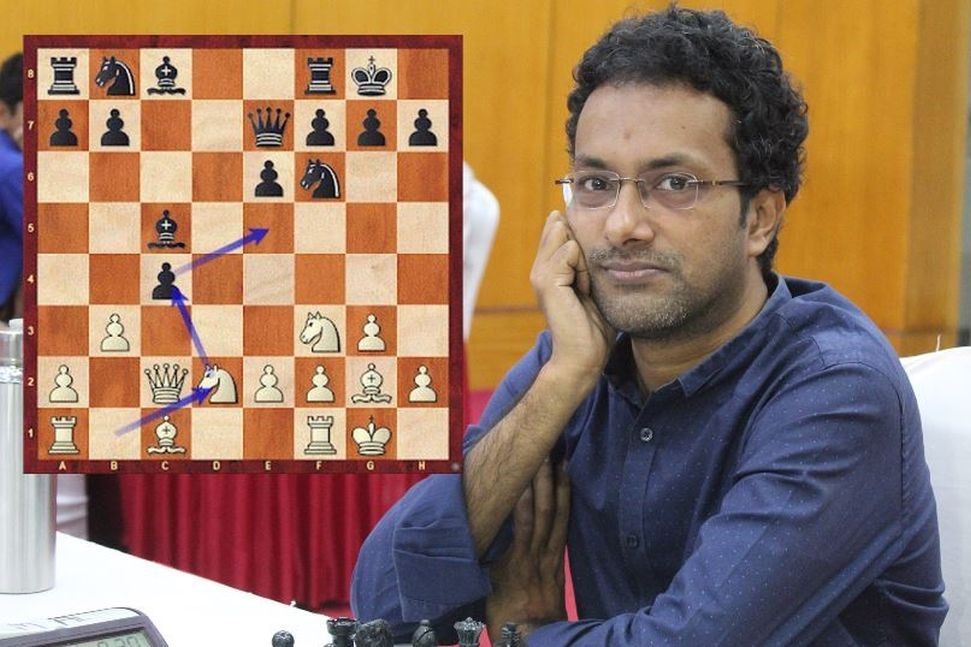One for the history books
“Staring at the abyssmal depths of chess” - Jonathan Rowson
The World Chess Championship between Magnus Carlsen and Ian Nepomniachtchi is covered most extensively, and is perhaps the only time in my memory where so many living legends commented upon the games live. Vishy Anand, Vladimir Kramnik, Peter Svidler, Fabiano Caruana, Vasyl Ivanchuk and Judit Polgar all commented live in various channels. There were numerous others too, but just looking at the names I could not help imagining myself as Buridan’s ass, unable to make a proper choice!
With all the talks of draws and death of classical chess in World Championships in the background, the sixth game of the match destroyed all such illusions. It was the most gruelling World Championship slugfest I have ever seen! To get into the depths of such a fascinating game is beyond the depths of a mortal human, so I will restrict myself to jotting down several interesting moments from this classic.
Carlsen, M. vs Nepomniachtchi, I.
2021 World Championship Match - Game 6
10.Nbd2!?
 Let our authors show you how Carlsen tailored his openings to be able to outplay his opponents strategically in the middlegame or to obtain an enduring advantage into the endgame.
Let our authors show you how Carlsen tailored his openings to be able to outplay his opponents strategically in the middlegame or to obtain an enduring advantage into the endgame.A very interesting and rare line, but a typical Catalan theme of sacrificing a pawn in the opening. Carlsen showed his intentions, that he was geared up for a long and uncompromising fight. Kramnik admitted that despite being a Catalan player throughout his life for both colours, he had never actually studied this particular position or line.

Kramnik and Svidler during the game 6 live commentary on Levitov Chess channel | Photo: Levitov Chess live stream
There were some chaotic and fun lines analysed by Kramnik and Svidler in Ilya Levitov’s YouTube channel. A rather romantic and chivalrous line where no one is sure what is really happening! Such is the depth and beauty of chess.
17...gxf6!
The idea of exchanging the dark-squared bishop for Black’s knight is a possibility in a Catalan, and Black rightly refrains from exchanging queens at the moment. If he does so, even though Black has the bishop pair in the endgame, there are some problems he will have to face. The doubled pawns on f6 might become a concern, plus he has to live with the weakness of the square c5 because of having played b5.
And also it is very important to note the wonderful placement of the knight on d3 from where it blocks the d-file and is ready to jump to c5 or f4, as required. Ivanchuk, with his inimitable erudition, referred to this knight as Romanishin’s knight. The origin of such a name is beyond my knowledge of those classical games. Note to myself: check Romanishin’s games on these structures.
I was reminded of two games in these structures where a pure knight versus bishop endgame can be a big headache for Black. Ulf Andersson vs Sergey Ivanov (Sweden 2000) and the first game of Kramnik vs Deep Fritz (Bonn 2006). These two games (among many others, surely) illustrate the dangers of such endgames. One needs to pay attention to these positions more minutely. I came across Ulf’s particular game in Jacob Aagard’s Excelling at Positional Chess, I believe.
From Black’s point of view, it made absolute sense to keep queens on the board and only exchange them under more favourable circumstances. I could not help but remember Seirawan vs Ivanchuk (Amber Rapid 1994) in this regard, which too deserves a closer look. Ivanchuk would go on to exchange queens under favourable circumstances and win a rook and knight versus rook and bishop endgame.
This interesting and instructive moment came after Black’s 24th move Kg7. Kramnik was explaining prophylactic thinking with the position before 24...Kg7. He said it will be useful for Black to question what White intends to do, and then one can come up with the idea that White wants to play e3 and Qe2 to improve the position a little bit.
So, instead of 24...Kg7, Kramnik’s suggestion was 24...Rd5 with the idea of meeting 25.e3 with 25...Bxe3 26.fxe3 Rad8!. It was very interesting to observe his thought process. In this regard, he is a successor of Karpov in his approach to the game — always looking at the position from the opponent’s angle.
 This DVD allows you to learn from the example of one of the best players in the history of chess and from the explanations of the authors (Pelletier, Marin, Müller and Reeh) how to successfully organise your games strategically, consequently how to keep y
This DVD allows you to learn from the example of one of the best players in the history of chess and from the explanations of the authors (Pelletier, Marin, Müller and Reeh) how to successfully organise your games strategically, consequently how to keep yAnand, Ivanchuk and Kramnik all felt that White’s position was more pleasant after 25.e3!? but the World Champion thought for a long time before continuing with 25.Rd2!? demonstrating the depth and richness of chess. When he indeed avoided playing 25.e3 at this moment, I was drawn towards the thought that perhaps he did not want to loosen the stable post for his knight on d3 in an eventual endgame versus the dark-squared bishop, as this is what happened in his game versus Karjakin in their first game of the World Championship match 2016, which started from a Trompovsky. (Or perhaps Magnus’ reasoning was entirely different!).
This endgame needs to be studied in addition to the Andersson and Kramnik games mentioned earlier. In passing, I would also like to mention Kramnik’s version of how Andersson became a very strong endgame player. Apparently he would play casual games with his friends by removing queens for both sides from the start position; sometimes queen and a minor piece; and sometimes some changes in pawns, etcetera.
Black had answered 25.Rd2 with 25...Rac8 provoking an exchange of two rooks for a queen. After a while, we reached this position. This particular exchange is a huge topic in itself and one that is not easy to understand. Here the experts preferred White, and the way the game went reinforced their opinion.
The question of king safety is a very important feature in evaluating positions with queen against two rooks. Here White’s king is safe and, relatively, Black’s king is not. The doubled pawns themselves can turn out to be weak especially since White has a knight and there are possibilities of White launching an attack against Black’s king with his two rooks and a knight. Especially vulnerable are the light squares, like the pawn on f7, and sometimes the g8 square when White infiltrates both his rooks to the eighth rank and so on.
In the position from the diagram, White continued
30.h4!
This was a wonderful move which Carlsen played in time trouble with five minutes left on his clock for his remaining ten moves. This quickly dispelled the illusion of White being happy with a draw. He further safeguards his kingside structure before embarking on any further operations. As tempo play is definitely not the need of the hour. Nepo answered
30....h5?!
The pawn thrust h4 many a time elicits a similar response from the opponent. But, here it is clearly a problem, as Black abandons his h-pawn to a light square and it does not have a pawn to protect itself because of the doubled pawns. This is clearly a concession from a positional point of view.
31.Kh2!
This was another star move, taking some more time to secure the king and stop eventual checks before proceeding further. Carlsen made this move with just three minutes (and no increment) remaining on the clock. Kramnik was also expecting this. Kramnik noted an important weakness of chess engines: he felt that they were not good at evaluating queen versus pieces material imbalances. There is a tendency for the engines to overestimate the queen’s power. This has always been the case, but apparently even now engines find this too abstract to understand.
In this regard, he quoted his game as White against Ding Liren from the Berlin Candidates 2018. That was prophetic! Little could he have known a very similar occurrence was going to happen in this very game.
 The Catalan is one of the most solid openings for White. It forms part of the large and strong fianchetto family in which White builds his strategy mainly around the bishop on g2. Grandmaster Victor Bologan covers all of Black’s replies to the Catalan, some of which can even transpose to other openings such as the Tarrasch System and the Queen’s Indian. Suffice it to say that the Catalan rules!
The Catalan is one of the most solid openings for White. It forms part of the large and strong fianchetto family in which White builds his strategy mainly around the bishop on g2. Grandmaster Victor Bologan covers all of Black’s replies to the Catalan, some of which can even transpose to other openings such as the Tarrasch System and the Queen’s Indian. Suffice it to say that the Catalan rules!From my own experience, I know engines used to overestimate the queen versus three minor pieces position arising in a Gruenfeld. But that was a decade ago. For example, check the game Aronian vs Sutovsky (Reykjavik 2004). In this regard, I remember a game of Ivanchuk versus Aronian from the Russian Team Championship 2006 which was won by Ivanchuk. In it, the Ukrainian had three minor pieces against Aronian’s queen in an Anti-Marshall. Kasparov once commented in New In Chess that engines dissuaded the top players, including himself, from realizing the potential for White in that line as they always assess it in Black’s favour.
Here Magnus erred with 33.Rd1?. White should have maintained coordination with 33.Rcc2! intending to meet 33... Bxa3 with 34.Nf4! Qxb4 and 35.Rd7, and White’s attack crashes through.
Magnus was extremely short of time, and we need to remember that there was no increment. Slowly Nepo was also catching up in time trouble. Kramnik once again was expecting 33.Rcc2!. Apparently, Black is even better after Magnus’ mistake, although one is not sure about the extent of Black’s advantage. Perhaps White has enough resources to draw. However, the time trouble phase had huge drama in store for spectators.
In this position, Black refrained from taking 35...Bxb4 and perhaps wanted more with 35...e5. At this moment, Nepo was quickly catching up in terms of time trouble. If he had captured on b4, he perhaps would have had no danger of losing the game as White lacks coordination to win the a-pawn in the first place. Black is surely better, but maybe White will hold it with solid play.
Move 40 and Magnus went for the most natural 40.Nxe4. However, he had a cute little domination in the form of 40.Rdc2! f5 41.Nxa4 Qxa4 42.Rdc3, and in a 4 versus 4 pawn structure and doubled f-pawns, Black will lose the game slowly. Here the game was just beginning, it seems!

An interesting variation shown by Evgenij Miroshnichenko | Photo: Levitov Chess live stream
Annotators were showing a lot of imaginative and fun lines. This, for example, found by Miro. This position arose after not so forcing lines and quite far from the actual game, but here Black is powerless with two queens to stop a mate, so he sacrifices all his pieces with ....Be7 Rxe7 Qh1+ Kh1 Qd1+ Kg2 Qh1+ and draws the game with a stalemate trick.
After move 82, this position was reached, and it was well past midnight, and I decided to call it a day as a spectator and fell asleep. Magnus, however, was only getting started! Remember the game Kramnik-Ding Liren Berlin 2018 that Kramnik was talking about earlier? White has got a much favourable version compared to that.
The fact that, in computer terms, this game is a draw does not make any relevance to a practical game. It is very hard to defend this position, as Kramnik rightly pointed out. Maybe the computer will draw with its constant ability to accurately calculate and find some perpetual checks in long lines, but this is hardly possible for a human, and especially so for a defender. We think in terms of plans and ideas, and the resources to save more often than not remain behind a veil to us.
Here Giri pointed out that 118...Qb6! draws instead of Nepo’s 118...Qa5.
Intending to force the knight to d4 and keep White’s pieces tied up by means of a pin. Maybe pinning the knight with the queen can be a reasonable way to approach this otherwise complex position, which I do not claim to know anything about! This endgame needs to be checked in detail and at leisure.
 In over 4 hours in front of the camera, Karsten Müller presents to you sensations from the world of endgames - partly reaching far beyond standard techniques and rules of thumb - and rounds off with some cases of with own examples.
In over 4 hours in front of the camera, Karsten Müller presents to you sensations from the world of endgames - partly reaching far beyond standard techniques and rules of thumb - and rounds off with some cases of with own examples.Anish Giri himself defended a marathon game against Magnus in Tata Steel 2017 where he had a lone queen against Magnus’ rook, light-squared bishop and h and g-pawns. He defended really well to draw the game. There was an extra defensive idea of wrong-coloured bishop in those positions.
However, even f and g-pawns, rook and dark-squared bishop against a lone queen did not prove to be sufficient to win in another game that I had watched live: Vijayalakshmi vs Xu Jun (Doha 2014). It seems to me that rook, knight and two connected passed pawns pose more of a problem against a lone queen than rook, bishop and two connected passed pawns. This is perhaps because of the unique L-shaped movement of the knight — as pointed out by Magnus and Anish — which the queen finds hard to combat. A bishop’s movement is within her reach!
Final position after move 136, the longest-ever game in World Championship history. White’s king can go to g8 and hide from checks. Phew! This drama needs to be fathomed in for months to come.

Over 7 hours of deep focus | Photo: Niki Riga
You can go through the games mentioned in the article in the dynamic replayer below.
Select an entry from the list to switch between games
Links


























